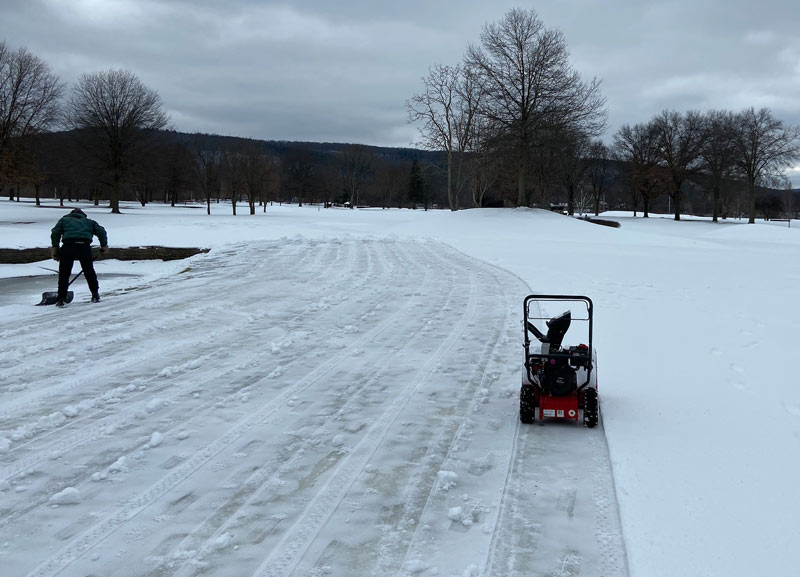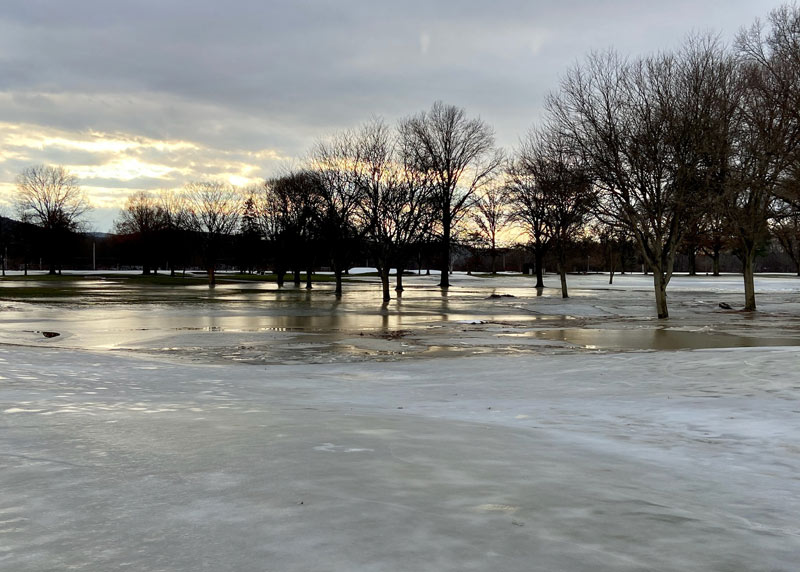
The frozen tundra of En-Joie Golf Club in Endicott, N.Y., the result of snow, rain, a flood and a deep freeze in late December 2020. Photos courtesy of Anthony Chapman
Anthony Chapman thought he’d seen it all.
Devastating floods. Debris on the grounds. Waist-deep snow.
But Chapman, the GCSAA Class A superintendent at En-Joie Golf Club in Endicott, N.Y., is encountering an unfamiliar challenge, and he’s going to have to dig deep — but not too deep — to remedy the situation.
Late December 2020 was not kind to En-Joie: 40 inches of snow followed by 2 inches of rain and severe flooding from both Nanticoke Creek and the Susquehanna River — the latter of which rose to more than 25 feet in the flood-prone area — all capped by a deep freeze. The combination buried some parts of En-Joie in a sea of solid ice. Chapman, a nine-year GCSAA member, tells GCM he estimates up to 30 acres of course turf, including at least 12 fairways and six California bentgrass/Poa annua greens, are ice-covered, some with ice up to 4 feet thick.
Work to unearth the turf from its frozen coating has already been underway despite no major thaw in sight, and it will continue in earnest at the facility, which is set to welcome a PGA Tour Champions event this summer.

En-Joie’s first hole, which has a flat green and is located in a low spot, was among the hardest hit.
What makes this weather event so different for Chapman amounts to a four-letter word: silt. It can hamper water infiltration into the soil profile and cause injury to the turf as well as drainage issues. Six greens were encased in ice atop silt, which Chapman says is unlike anything he has come up against before.
“Now, we’re dealing with something really, really new. We’re not used to silt in the winter,” Chapman says of the material, which is a remnant of the flooding, “and especially since it has ice on top of it. We’ve had ice on greens before, including the last two years, but it wasn’t real harsh. We’ve had surfaces covered in it (ice) for 30, 40, 50 days. But that didn’t have silt under it. It’s hard to clear out the silt because it’s hard to get a water source near them (the greens), because the ponds froze. It’s become our unknown. Our challenge. I’m worried about it.”
Some of the chipping-away process has begun, and Chapman says he and the small crew currently on hand are increasing their efforts to clear the ice, which will hopefully lead to the removal of the silt.
Chapman has an arsenal of thin-blade aluminum scoop shovels. He and his crew will slip a shovel underneath a section of ice and attempt to pop it up and flip it over, at which point it can then be brushed off the green and into a nearby pond. One of those greens by a pond, No. 1, is entirely iced, including the approaches.
In the past, Chapman has used other implements for ice removal, but he has decided to shelve those options this go-around. “We’ve used picks and hammers, but it damaged the turf — something you can see when the turf starts to grow in the spring,” he says. “We want to be careful.”

A long way from July: En-Joie Golf Club is scheduled to host the Dick’s Sporting Goods Open, a PGA Tour Champions event, over the July Fourth weekend.
Flood and silt issues are a constant at En-Joie, where renowned golf course architect Michael Hurdzan, Ph.D., led a renovation in the late 1990s. To try to counter the siltation problem, Hurdzan created silting basins (in the roughs and along property lines, for example) where some of the floodwater could be slowed down enough to drop some of its silt load to help reduce siltation on fairways or other flooded areas. In theory, these silt basins could be periodically cleaned out in preparation for the next flood event. Still, Hurdzan says he understands the menace of silt when the quantity of floodwater is excessive. “Silt — that’s the killer,” he says. “It is so insidious.”
Going forward, Chapman plans to rely on part of his staff that had been laid off for the winter making an earlier comeback than expected to help with what at the moment is a daunting scenario. Currently, only Chapman, assistant superintendent Kyle Corcoran and equipment manager John Mazar are on duty.
For the three of them, simply navigating the course is difficult. Chapman doesn’t have snowmobiles, and turf tractors, with their tires, aren’t necessarily the best option (although they did give it a try and were able reach No. 15 that way last weekend to chip ice off the green).
Chapman left his wife and two children for a few hours on Christmas Day to check up on the course. “I couldn’t drive anywhere, so I put my boots on and prepared for a walk. As I looked down toward the lower end of the course, I just put my head down and thought, ‘Here we go again.’ I walked along the flood wall, and it was a couple feet (high). When water starts running up you on both sides, you get a little nervous.”
Yet not necessarily surprised. In 2011, Chapman was on the crew of superintendent Rocco Greco when Tropical Storm Lee pummeled En-Joie, leaving some holes 24 feet under water. The course was closed from September until June 2012. Chapman, who became En-Joie’s superintendent seven years ago, knows he has to be prepared for anything. For example, he’s already talking about verticutting in April and aerifying at some point. Sodding or seeding? Who knows, Chapman says. First things first, though: “Clearing off the greens is the top priority. We can’t have that silt sit all winter,” he says.

The 15th green at En-Joie following ice removal.
A key part of the urgency is the PGA Tour Champions’ Dick’s Sporting Goods Open, scheduled July 2-4 at En-Joie. Chapman was on a conference call this past week with the Tour and its agronomist to discuss what’s happening at En-Joie. Now, all that concerns Chapman is what will happen.
“There’s nothing you can do about the weather and what happened. You go out, get to work, get it back in shape to where it should be so you can feel good again,” says Chapman, whose recovery efforts were slowed by more snow last weekend. “I just hope we can get a little sun.”
Howard Richman is GCM’s associate editor.